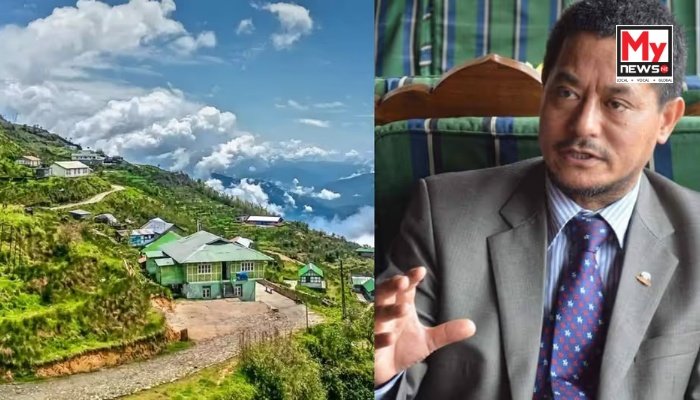Sikkim Envisions Eco-Centric Future by 2047
Gangtok: As Sikkim marks its golden jubilee since merging with India, a profound vision for its future has emerged, championed by Professor Mahendra P. Lama, the Chief Economic Advisor to the Government of Sikkim and a distinguished Senior Professor at Jawaharlal Nehru University. Professor Lama envisions Sikkim transforming into India’s premier “green destination” by 2047, intertwining every facet of its development with sustainable practices.
Speaking on a podcast commemorating Sikkim’s journey from a monarchy to an integral part of the Indian Union in 1975, Professor Lama reflected on the unique trajectory of this tiny Himalayan kingdom. He lauded Sikkim’s evolution into one of India’s most peaceful and progressive states, attributing its distinct identity to four robust pillars: its rich political history, unparalleled biodiversity, harmonious cultural fabric, and the constitutional safeguards provided by Article 371F. These elements, he emphasized, have been instrumental in preserving Sikkim’s individuality while ensuring its seamless integration into the Indian Union.
Professor Lama underscored Sikkim’s remarkable stability, noting, “Unlike many other northeastern states, Sikkim has remained peaceful. There’s no insurgency, no violence. It is socially cohesive and politically stable.” This tranquility is mirrored in its economic progress; Sikkim’s per capita income stands at an impressive ₹7.5 lakh, ranking among the highest nationally. A stark contrast to 1975, when nearly 85% of its populace lived below the poverty line, today that figure has plummeted to a mere 2%.
Despite these significant strides, the journey has not been without its hurdles. Professor Lama candidly pointed out Sikkim’s biggest challenge: connectivity. “We are the most integrated state in India emotionally and institutionally, but the least connected physically,” he observed, highlighting the precarious nature of its single national highway, often blocked for months, and an underused airport. He stressed the urgent need for enhanced transport infrastructure, including vital rail and road links.
Compounding these challenges is the palpable threat of climate change. The devastating glacial lake outburst flood in October 2023 served as a stark reminder of Sikkim’s environmental vulnerability. “We are victims of disaster but are rarely considered part of the solution. Sikkim must become a knowledge hub for climate resilience,” Professor Lama asserted, advocating for the state to play a pivotal role in climate adaptation strategies.
Looking ahead, Professor Lama presented a transformative blueprint for Sikkim’s future. “By 2047, Sikkim wants to be known as India’s green destination where every activity, from energy to agriculture, tourism to transport, is rooted in sustainability,” he declared. His vision calls for embracing green technology, fostering eco-friendly entrepreneurship, and establishing second-generation institutions dedicated to climate adaptation, disaster preparedness, and promoting green industries.
Crucially, Professor Lama emphasized that Sikkim’s development trajectory cannot mimic the industrial models of states like Tamil Nadu or Gujarat. “We have fragile ecosystems, limited carrying capacity, and a rich cultural and ecological heritage that must be preserved,” he explained. He passionately advocated for a development model specifically tailored to mountain states, one that could serve as a blueprint for Uttarakhand, Himachal Pradesh, and even neighboring countries like Bhutan and Nepal.
Sikkim’s strategic geographical location, bordering China, Nepal, and Bhutan, positions it at the heart of India’s Act East Policy. Professor Lama championed a paradigm shift in viewing borders, not merely as lines of defense, but as zones of cooperation. He believes the state can serve as a vital “bridge for cross-border trade, tourism, education, and energy exchange with the Himalayan region and Southeast Asia.”
To realize this ambitious goal, proposals such as reopening trade routes with Tibet, establishing an economic corridor between West Sikkim and East Nepal, and integrating with regional power grids are actively being considered. Sikkim’s deep-rooted cultural and geographical ties with its neighbors make it uniquely poised to spearhead such regional cooperation initiatives.
As India marches towards its goal of becoming a developed nation by 2047, Professor Lama firmly believes that Sikkim’s contribution will not be through heavy industries, but by leading the charge in sustainability and environmental innovation. “Our role is to show how development can go hand in hand with nature. If we protect our resources, we protect not just Sikkim, but the entire region,” he concluded, encapsulating Sikkim’s profound commitment to a greener, more sustainable future for itself and beyond.
Read More: Assam: Jaginga-Lampu NH-27 Section Closed Due to Major Landslide

